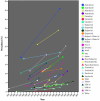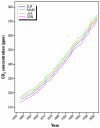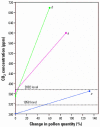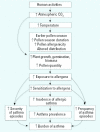Is the global rise of asthma an early impact of anthropogenic climate change?
- PMID: 16079058
- PMCID: PMC1280328
- DOI: 10.1289/ehp.7724
Is the global rise of asthma an early impact of anthropogenic climate change?
Abstract
The increase in asthma incidence, prevalence, and morbidity over recent decades presents a significant challenge to public health. Pollen is an important trigger of some types of asthma, and both pollen quantity and season depend on climatic and meteorologic variables. Over the same period as the global rise in asthma, there have been considerable increases in atmospheric carbon dioxide concentration and global average surface temperature. We hypothesize anthropogenic climate change as a plausible contributor to the rise in asthma. Greater concentrations of carbon dioxide and higher temperatures may increase pollen quantity and induce longer pollen seasons. Pollen allergenicity can also increase as a result of these changes in climate. Exposure in early life to a more allergenic environment may also provoke the development of other atopic conditions, such as eczema and allergic rhinitis. Although the etiology of asthma is complex, the recent global rise in asthma could be an early health effect of anthropogenic climate change.
Figures




Similar articles
-
The effects of climate change on respiratory allergy and asthma induced by pollen and mold allergens.Allergy. 2020 Sep;75(9):2219-2228. doi: 10.1111/all.14476. Epub 2020 Aug 5. Allergy. 2020. PMID: 32589303 Review.
-
Impacts of climate change on aeroallergens: past and future.Clin Exp Allergy. 2004 Oct;34(10):1507-13. doi: 10.1111/j.1365-2222.2004.02061.x. Clin Exp Allergy. 2004. PMID: 15479264 Review.
-
News on Climate Change, Air Pollution, and Allergic Triggers of Asthma.J Investig Allergol Clin Immunol. 2018;28(2):91-97. doi: 10.18176/jiaci.0228. Epub 2018 Jan 17. J Investig Allergol Clin Immunol. 2018. PMID: 29345235 Review.
-
Changing pollen types/concentrations/distribution in the United States: fact or fiction?Curr Allergy Asthma Rep. 2008 Sep;8(5):418-24. doi: 10.1007/s11882-008-0081-z. Curr Allergy Asthma Rep. 2008. PMID: 18682110 Review.
-
Climate change, air pollution, pollen allergy and extreme atmospheric events.Curr Opin Pediatr. 2023 Jun 1;35(3):356-361. doi: 10.1097/MOP.0000000000001237. Epub 2023 Mar 14. Curr Opin Pediatr. 2023. PMID: 36917187 Review.
Cited by
-
Adaptation to impacts of climate change on aeroallergens and allergic respiratory diseases.Int J Environ Res Public Health. 2010 Aug;7(8):3006-21. doi: 10.3390/ijerph7083006. Epub 2010 Jul 28. Int J Environ Res Public Health. 2010. PMID: 20948943 Free PMC article. Review.
-
Is enough attention given to climate change in health service planning? An Australian perspective.Glob Health Action. 2014 Jun 18;7:23903. doi: 10.3402/gha.v7.23903. eCollection 2014. Glob Health Action. 2014. PMID: 24947804 Free PMC article.
-
Global climate change and children's health: threats and strategies for prevention.Environ Health Perspect. 2011 Mar;119(3):291-8. doi: 10.1289/ehp.1002233. Epub 2010 Oct 14. Environ Health Perspect. 2011. PMID: 20947468 Free PMC article. Review.
-
Fine-Scale Exposure to Allergenic Pollen in the Urban Environment: Evaluation of Land Use Regression Approach.Environ Health Perspect. 2016 May;124(5):619-26. doi: 10.1289/ehp.1509761. Epub 2015 Oct 9. Environ Health Perspect. 2016. PMID: 26452296 Free PMC article.
-
Uncertainties associated with quantifying climate change impacts on human health: a case study for diarrhea.Environ Health Perspect. 2011 Mar;119(3):299-305. doi: 10.1289/ehp.1002060. Epub 2010 Oct 6. Environ Health Perspect. 2011. PMID: 20929684 Free PMC article.
References
-
- Albritton DL, Meira Filho LG, Cubasch U, Dai X, Ding Y, Griggs DJ, et al. 2001. Technical summary. In: Climate Change 2001: The Scientific Basis. Contribution of Working Group I to the Third Assessment Report of the Intergovernmental Panel on Climate Change (Houghton JT, Ding Y, Griggs DJ, Noguer M, van der Linden PJ, Dai X, et al., eds). Cambridge, UK:Cambridge University Press, 21–83.
-
- Bach J-F. The effect of infections on susceptibility to autoimmune and allergic diseases. N Engl J Med. 2002;347:911–920. - PubMed
MeSH terms
Substances
LinkOut - more resources
Full Text Sources
Medical

